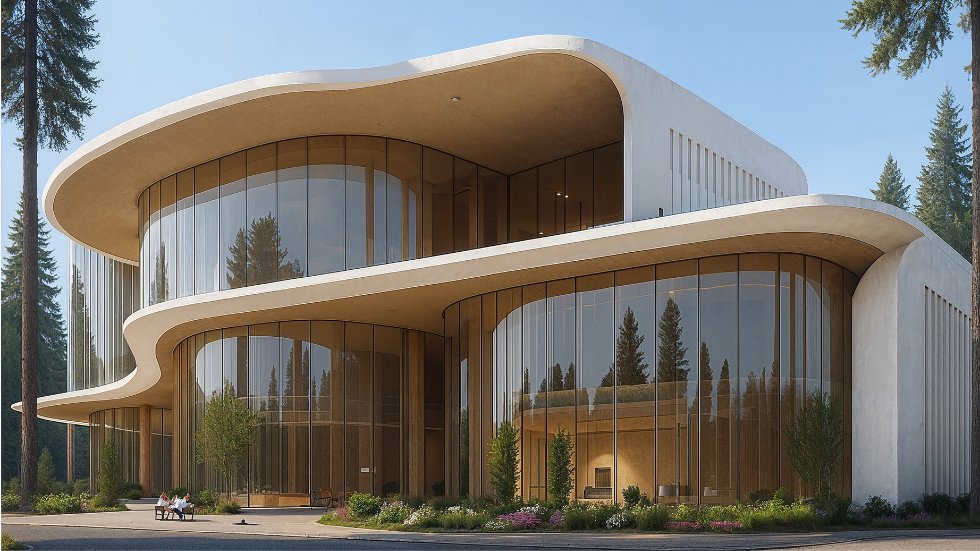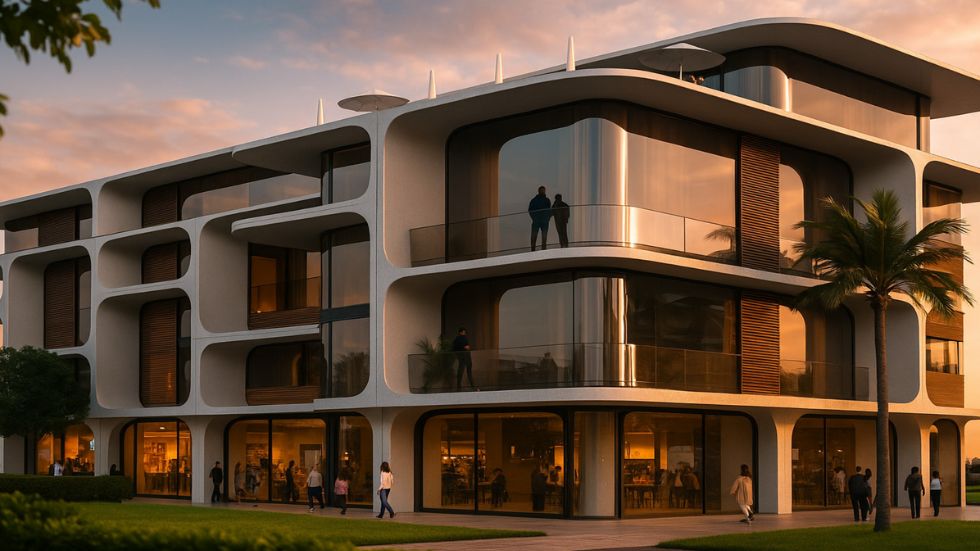- The Malahat Nation is adopting advanced AI-powered master planning to create sustainable, community-led housing rooted in cultural values and environmental stewardship.
- In partnership with Zaha Hadid Architects and Archistar, the project uses generative design to rapidly explore modular housing options optimized for local terrain and community needs.
- Data-driven urban planning demonstrates how technology, tradition, and design innovation can work together to build developments that communities love.
In the south of Vancouver Island, just north of the historic town of Victoria, ancient Douglas Fir and red-barked Arbutus evergreen trees surround the landmark Spiral Tower that offers a breathtaking view atop the Malahat Summit. More than 350 meters below, the steadily sloped land gives way to the scenic Saanich Inlet, where fortunate timing may afford a peak at orcas, humpback whales, or dolphins piercing the water’s surface.
This is the Malahat Nation, representing an indigenous community of approximately 350 members. Malahat Nation is strongly committed to sustainability, community engagement, and its own sovereignty. Pursuing effective new solutions to address its housing challenges, the Nation has embarked on an innovative, multi-tiered partnership for an AI-powered, data-driven approach to master planning community housing projects.
Through the digital innovation ecosystem of the Canadian not-for-profit organization DIGITAL, Malahat Nation has partnered with Archistar to use its 3D Generative AI Building Design technology, which generates 3D designs of buildings and urban master planning optimized for zoning laws, environmental factors, and community-lead decisions.

Generative design figure topologies from ZHA for the Malahat Nation master planning project. Courtesy of Zaha Hadid Architects.
AI Master Planning with Computational Design Masters
The final puzzle piece to this partnership fits the need for generating efficient modular housing that can adapt to the community-driven decisions of the Malahat Nation. Zaha Hadid Architects (ZHA) is best known for the iconic and complex curved geometry of Zaha Hadid’s (1950–2016) original building designs. The firm has been a leading light in computational design to achieve its fluid architectural structures for many years.
ZHA Associate Director Shajay Bhooshan co-founded ZHACODE, the firm’s internal computational design research group, and is leading ZHA’s collaboration on the Malahat Nation development project.
With Bhooshan at the helm, ZHA has been researching and experimenting with creating developments from a kit of customized modular parts while strengthening community ties both in the physical world and in digital simulations since 2016. At that time, ZHA created a demo inside the Fortnite video game using Unreal Engine, where users could “buy” land and build communities using modular parts.
“Video games are a beautiful medium to explore systems of trade-off,” Bhoosan says, noting how they often balance cost, benefit, and happiness just as urban designers do. “We’ve been inspired by how games deal with finite resources and how people create communities in virtual worlds for a long time.”
Recently, ZHA built the physical prototype version of this modular system for a master planning project in Honduras. That project involved creating a custom kit of modular parts for the specific local needs of that project and then also creating a local microfactory that would build those parts.
Just like in Honduras, Bhooshan says ZHA’s work with the Malahat Nation project is twofold: “One is to evolve our system prototypes—how a modular kit of parts can combine to create various mid-rise and low-density housing modules that we haven’t done before,” he says. “And the other is developing custom parts that work with the complex terrain of the land and the specifics of the Malahat Nation community.”

Rendering of a ZHA's Stable Diffusion Look Development for Malahat Nation. Courtesy of Zaha Hadid Architects.
Community-Based Rapid Iteration
According to Tristan Gale, Director, Economic Development, Malahat Nation, the success of this project hinges on the ability to iterate rapidly on the development’s master plan in response to Malahat community input.
“Malahat needs to see a suite of viable master planned futures as a starting point for evolving those options into something that Malahat people can call their own,” Gale says. “Archistar’s technology offers rapid iteration on these master planned options.”
In the early stages of this collaboration, ZHA needed to integrate its modular component designs with Archistar’s AI platform, something Bhooshan says did not take too much extra work, since ZHA was already creating its digital design system.
With ZHA’s designs integrated, Archistar’s generative design platform could then create many community development options. Each variation is GIS-based and optimized for the slope of the land, the housing mix and building heights the community wanted, and the available green space. Those options could then be shared easily with the Malahat community and referred to during planning discussions.
“Malahat Nation is wealthy in many ways: culture, land, community, and traditional wisdom,” Gale says. “Translating this value into sustainable businesses that are self-supporting and aligned with Malahat’s values is an incredibly complex problem. Leveraging emerging technologies is already sparking deeper levels of conversation around Malahat’s bright future.”

An early Malahat Nation concept plan using Archistar's precinct generator tool.
Skillful Use of Generative Design
The rapid iteration of Archistar’s generative platform allows the prospect of AI-driven master planning that keeps human communities in control. Malahat’s Project Team can quickly peruse many options and show the most promising possibilities to the Malahat Members, who can give additional input.
Gale says he’s confident that they’ll arrive at what he calls “a vision of the future that reflects the unique identity of Malahat Nation in this development’s function and form.”
Bhooshan is also a big believer in generative design. But he notes that using it successfully requires familiarity and experience with the tools to best design not only the ideal kit of modular parts—in this case—but also the rules by which those parts are combined.
ZHA has accrued that experience over many iterations, he says, first with a simulated world in the Fortnite demo, then with their microfactory project in Honduras, and now by designing the modular components for the Malahat Nation project.
“Generative design systems are very useful to search through a world of possibilities,” Bhooshan says, “but we have to construct those possibilities first. You have to design the system to produce novelty and uniqueness and variation, to adapt many things to the client and the landscape. It’s not easy to get that without sufficient design research.”
However, when wielded skillfully, AI master planning with generative design can optimize developments for the contours of the land, wind patterns, solar exposure patterns, and even very customized constraints. For example, ZHA had to consider how it would design around sacred sites and environmental synergies that Malahat Nation specified.
“These are very high-level things that all architects should be doing,” Bhooshan says, “but surprisingly, not many actually do.”

Generative design master planning options for Malahat Nation project. Courtesy of Zaha Hadid Architects.
How Love is the Key to Sustainability
The Malahat Nation is dedicated to sustainable growth that aligns with its traditions and honors its ancestors. By embracing these digital innovations, the Nation can explore customized housing solutions that its community deems worthy of its cultural identity while also leading in sustainability.
For one thing, Archistar’s generative AI for master planning technology generates abundant design options for maximizing efficiency, resource allocation, and reduced timelines. However, there’s more to sustainability than quantifiable statistics, as Bhooshan points out. Emotion and social bonds also play a role.
“The first and foremost instrument of sustainability is that buildings should not be demolished before their expiration date,” Bhooshan says. “For that, people need to love their community and their houses.”
In that sense, Bhooshan says that utilizing digital innovations to their fullest extent is the first step in sustainable building. With generative design’s abundant design alternatives combined with good design principles and community input, AI-assisted community planning can arrive at a development plan that people are likely to love. And it all happens in the digital domain before construction begins to use physical resources.
“The more parameters and the more stakeholders you can incorporate into your design process, the better,” he says. “Ecology is one aspect. Economy is another. And sociology could also be incorporated—like how communities form and relate to each other and how they use spaces differently from other communities.”

Residence type three from ZHA's Malahat Nation generative design master planning project. Courtesy of Zaha Hadid Architects.
A Living Lab for Long-Term Impact
Many products of digital technology and AI pass into irrelevancy almost immediately. However, each partner involved in this Malahat Nation project sees it as an opportunity to establish AI master planning as a proven model for projects extending well into the future.
“We want to create an indigenous municipal model,” says Shannon Ralfs, Malahat Nation’s Executive Director of Infrastructure and Capital Projects. She describes a model where there’s open communication between all neighboring cities and municipalities that leads to efficient land use according to the “traditional knowledge keepers’” comfort levels.
Gale says the key to a self-sufficient economic future for the Malahat Nation lies in infrastructure: power, water, wastewater, telecommunication, transportation, and emergency and municipal services.
“Additionally, Malahat has invested heavily in planning, permitting, legal, and financial frameworks that will be further strengthened by the finalization of Modern Treaty negotiations with Canada and British Columbia,” he says, “which are expected to conclude in the next year.”
This project is one of the first times ZHA has worked on mid-rise modular developments. Bhooshan sees it as crucial in setting a foundation for future projects that can adapt to local geographical and cultural conditions. “We’re adopting a global best practice,” he says, “and evolving technology to fit the very specific needs of the land and community of the Malahat Nation.”
In essence, land is finite, but the possibilities for land use are infinite. The generative digital technology behind AI master planning helps to sift through and optimize the possibilities for the specific layout of the land, as well as the community’s values. Malahat Nation and ZHA are taking the long view toward making lasting changes to development that put community priorities first.

